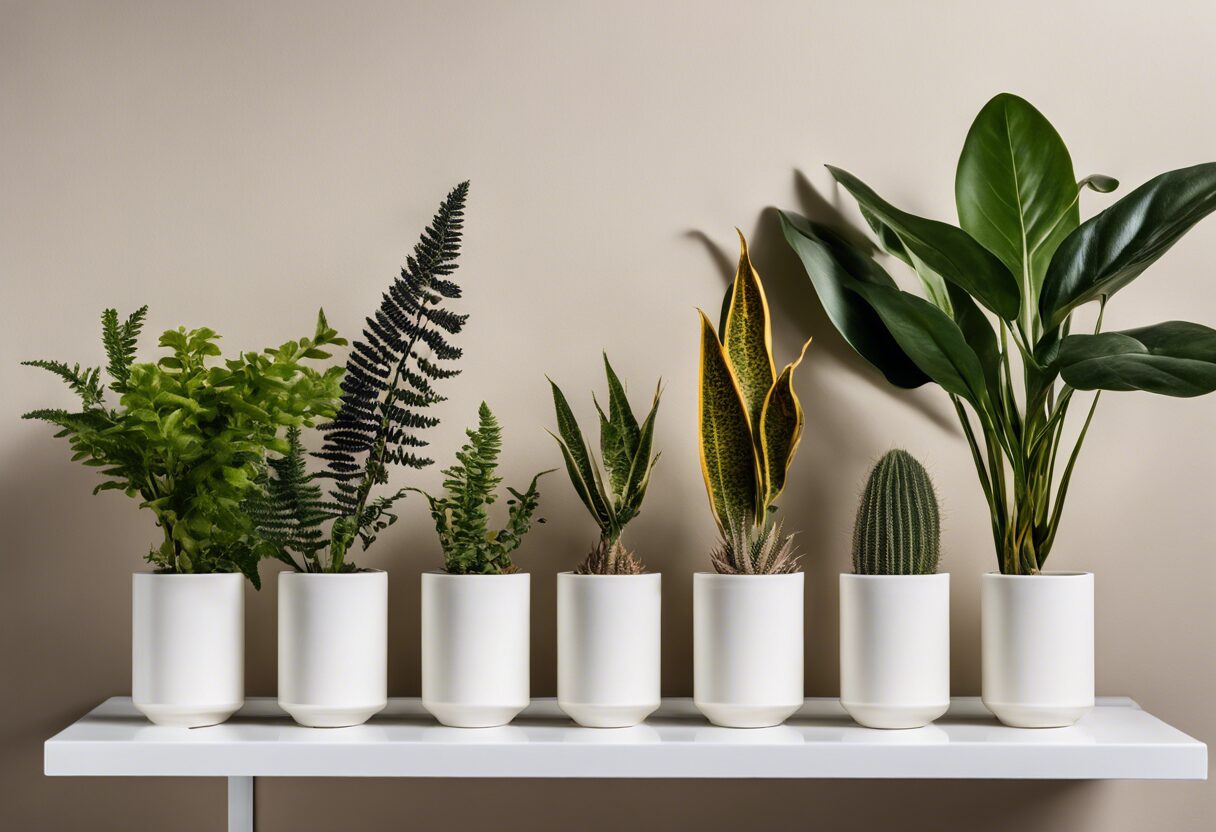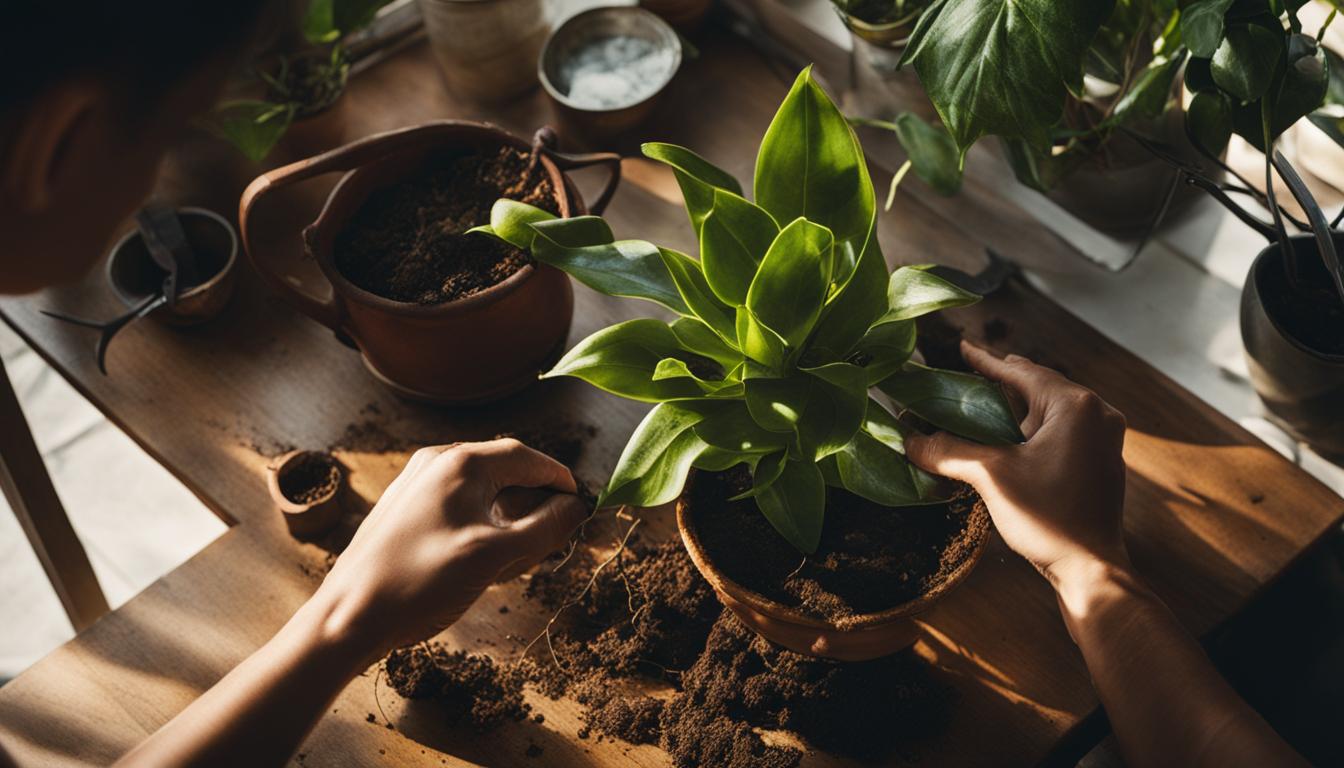Ever found yourself staring at your once lush and vibrant houseplant, now looking more like a dried-up tumbleweed? Well, you’re not alone. We’ve all been there, desperately Googling “how to revive a dying plant” while our green friends wilt away. But fret not! Reviving Indoor Plants doesn’t have to be a Herculean task.
In this blog post, we’ll explore the ins and outs of plant rescue missions. From diagnosing the problem to applying effective restoration techniques, we’ve got you covered. So let’s dive in and bring those leafy pals back to life! Keep reading about Reviving Indoor Plants: How to Rescue and Restore Your Houseplants.
Key Takeaways
- Identify signs of plant distress such as yellowing leaves, wilting, or slow growth.
- Overwatering and under-watering are common causes of indoor plant problems. Adjust watering schedule based on plant species and season.
- Ensure plants receive appropriate light levels; too much or too little can harm them.
- Repot plants if they outgrow their containers or the soil becomes depleted.
- Use fertilizers sparingly and according to specific plant needs.
- Prune dead or diseased parts to promote new growth.

Why Do Indoor Plants Wilt or Die?
Indoor plants can be a bit like Goldilocks, not too hot, not too cold, just right. But sometimes they wilt or die and it’s not always clear why. The reasons are often linked to indoor plant care and understanding the specific needs of your green friends.
Common Reasons for Indoor Plant Decline
The most common culprit? Overwatering. Yes, you can kill your plants with kindness! Overwatering indoor plants is a surefire way to invite root rot.
Another frequent issue is lack of sunlight. Your leafy pals need light to photosynthesize and grow. So if your plant is tucked away in a dark corner, it might start declining due to lack of sunlight.
And let’s not forget about those pesky houseplant pests. They’re tiny but mighty when it comes to damaging your indoor greenery. From spider mites to aphids, these little critters can cause big problems for your houseplant pests.
Lastly, temperature stress can also lead to a decline in maintaining indoor plants health. Too hot or too cold environments can shock the plant leading to wilting or even death.
Signs of a Struggling Indoor Plant
So how do you know if your indoor plant is sending out an SOS? Look out for yellow leaves. This could be a sign that something’s amiss with your plant’s health – maybe it’s getting too much water or not enough light?
Drooping stems are another red flag that your plant might be struggling. It could be due to overwatering or under watering – yes, both can cause drooping!
Slow growth is another sign that all may not be well in plant paradise. If your usually fast-growing pothos has slowed down its growth rate, it might be time for some TLC.
Finally, brown leaf tips can indicate a number of issues, from over-fertilization to low humidity. So keep an eye out for these signs and remember – reviving indoor plants is possible with a bit of care and attention!
How to Diagnose Your Indoor Plant’s Problem?


When it comes to reviving indoor plants, the first step is always diagnosis. It’s like playing detective with your green buddies. You need to check three main areas: leaves, soil, and roots. This indoor plant diagnosis is crucial for a successful plant health check.
Examining the Leaves
Now let’s start with the leaves, shall we? Leaf examination can reveal a lot about your plant’s health. Look out for yellowing or browning, spots, or curling edges. These are all indoor plant leaf symptoms that something ain’t right.
Common causes could be overwatering, underwatering, or not enough light. Remember folks, every leaf tells a story! So don’t ignore those unhealthy plant leaves.
Checking the Soil
Next up on our investigation list is the soil. The condition of your plant’s soil can say volumes about its wellbeing. Dry or waterlogged soil? Both are bad news bears for your green friends.
Assessing soil moisture level is as simple as sticking your finger in it (clean hands please!). If it feels dry an inch down, it’s time to water. On the flip side, if it’s sopping wet – you might be overdoing it on the H2O front.
Remember folks – balance is key when dealing with indoor plant soil condition!
Inspecting the Roots
Last but certainly not least – we have root inspection! Now this might get a bit dirty (literally), but trust me – it’s worth it! Healthy roots should be firm and white or light tan.
If they’re mushy or dark-colored – uh oh! Those are signs of root rot my friend. If you spot any creepy crawlies lurking around there too – that’s another red flag!
So there you have it folks, the ABCs of indoor plant root health. Remember, reviving indoor plants starts from the ground up – or in this case, the root up!



How to Revive a Dying Indoor Plant?
When it comes to reviving indoor plants, there’s no magic spell. It’s all about going back to the basics of indoor plant care. The three main areas you need to focus on are adjusting watering techniques, modifying light exposure, and changing soil or repotting.
Adjusting Watering Techniques
Water is life, right? Well, that’s true for your houseplants too! But here’s the catch – both overwatering and underwatering can lead to a dying plant. So how do you strike that balance?
Firstly, understand the water requirements for plants you own. Some like it wet (not soggy!), others prefer their soil on the dry side. If your plant is showing signs of overwatering or underwatering symptoms, it’s time to adjust your watering methods.
Remember, proper hydration for houseplants isn’t just about quantity but also frequency. It might be tempting to drown your wilting plant in water but resist! Instead, aim for consistent moisture levels in the soil.
Modifying Light Exposure
Next up on our list of plant revival methods is light exposure. Your indoor green buddies need light to photosynthesize and grow. But too much or too little can cause problems.
Start by understanding the indoor plants’ light requirements. Some plants love basking in bright sunlight while others thrive in low-light conditions. If your plant looks unhappy, consider adjusting its location or using artificial indoor lighting for plants.
Remember, when it comes to light exposure for houseplants, consistency is key! Sudden changes can stress out your plants more than help them recover.
Changing Soil or Repotting
Finally, let’s talk dirt – literally! Sometimes reviving a dying plant involves getting your hands dirty with some repotting action.
If your plant is looking sickly despite proper watering and lighting, it might be time to consider repotting houseplants. This could be due to a lack of nutrients in the soil or because your plant has become root-bound.
Choosing the right potting soil for indoor plants can make a world of difference. Look for signs of root-bound plants, like roots growing out of the drainage holes or circling the surface of the soil.
Remember, repotting is stressful for plants, so only do it if necessary. But when done right, it can give your plant a new lease on life!
What Are Some Effective Restoration Techniques for Houseplants?
So, you’ve noticed your beloved green buddy is looking a bit under the weather? Fear not! There are several houseplant restoration techniques that can bring your leafy friends back to their prime. Let’s delve into pruning and trimming, fertilizing and nutrient management, and pest control methods.
Pruning and Trimming
First things first, let’s talk about pruning. It’s like giving your plant a haircut. Proper pruning of houseplants can help restore their health by removing dead or diseased parts.
Now, don’t just go hacking away willy-nilly! There’s a right way to do it. Always use clean, sharp tools to avoid spreading disease. And remember, less is more when it comes to trimming indoor plants.
Fertilizing and Nutrient Management
Next up on our plant rescue mission is fertilizing and nutrient management. Just like us humans need a balanced diet, so do our plants!
Proper fertilization can be a game-changer in reviving ailing houseplants. But again, moderation is key here folks! Over-fertilizing can harm your plants more than help them.
And let’s not forget about nutrients! They’re crucial for plant health. So make sure you’re using suitable fertilizers for your indoor plants that contain all the necessary nutrients they need to thrive.
Pest Control Methods
Last but definitely not least on our list of effective plant care techniques is pest control. Those pesky bugs can wreak havoc on your indoor jungle!
There are various methods you can use to protect and revive your plants from harmful pests. From homemade sprays to store-bought insecticides – choose what works best for you.
Remember though, always test any new product on a small part of the plant first before going all out! We don’t want any casualties in the process of reviving indoor plants.
How to Prevent Future Problems with Your Houseplants?
Being proactive in preventing plant problems is like having a green thumb insurance policy. It’s all about regular monitoring, picking the right plants for your space, and understanding their seasonal needs.
Regular Monitoring and Care
Just like us humans, plants need regular check-ups too! A routine houseplant care can make a world of difference. It’s not just about watering them, but also checking for signs of distress or disease.
By keeping an eye on your leafy friends, you’re essentially preventing plant diseases before they become a major issue. So don’t forget that weekly indoor plant health check-up!
Choosing the Right Plants for Your Space
Now let’s talk about matchmaking – but for plants! Selecting indoor plants that suit your space can save you from many headaches down the line.
Some plants love sunlight; others prefer shade. Some thrive in humid conditions; others like it dry. By choosing the right plants for space, you’re setting them up for success and reducing potential problems.
Understanding Seasonal Needs of Plants
Plants have their own calendar, and they expect us to respect it! Understanding plant seasonal needs is crucial in maintaining their health.
Different seasons require different care routines. For instance, some plants go dormant in winter and need less water. By understanding these cycles, we can prevent seasonal issues from popping up.
Remember folks, when it comes to reviving indoor plants, prevention is better than cure!


To Wrap Up
Like a culinary wizard reviving a failed soufflé, we’ve whipped up some green-thumb magic to breathe life back into your wilting houseplants. From watering wisdom to sunlight savvy, our guide on Reviving Indoor Plants has you covered.
So, don’t give up on your leafy pals just yet! With a little TLC and patience, you’ll soon have them flourishing like a botanical garden in no time. Happy plant parenting!


